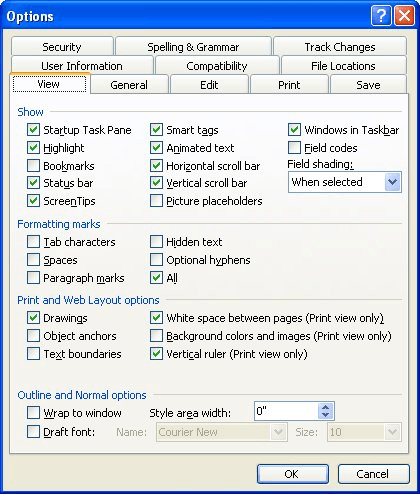Please Note: This article is written for users of the following Microsoft Word versions: 97, 2000, 2002, and 2003. If you are using a later version (Word 2007 or later), this tip may not work for you. For a version of this tip written specifically for later versions of Word, click here: Hiding and Displaying Hidden Text.
Written by Allen Wyatt (last updated April 16, 2020)
This tip applies to Word 97, 2000, 2002, and 2003
Hidden text is text that has the hidden attribute applied. In Word, hidden is a text attribute just like italics or bold. You can control whether hidden text is displayed or printed. When the display of hidden text is turned off, the text is not deleted, its display is simply suppressed—it is not shown. When you later display hidden text, it will all be displayed again.
To turn off the display of hidden text on the screen, follow these steps:

Figure 1. The View tab of the Options dialog box.
To later display hidden text, follow the same steps, but make sure the Hidden Text check box (step 3) is selected.
You can also control the display of hidden text (along with all other non-printing characters) by clicking on the Show/Hide tool on the toolbar. (This is the tool that contains the paragraph symbol; it looks like a backwards P.)
Turning off the display of hidden text presents a danger that you need to be aware of, however. When you turn it off, it doesn't show up at all on your screen. This makes it very easy to delete hidden text without even realizing it. This is especially true if you delete larger blocks of text, such as entire paragraphs.
The best way to guard against this is to make sure hidden text is always displayed when you are developing or editing your document. In this way you can be certain you won't inadvertently delete hidden text.
WordTips is your source for cost-effective Microsoft Word training. (Microsoft Word is the most popular word processing software in the world.) This tip (1645) applies to Microsoft Word 97, 2000, 2002, and 2003. You can find a version of this tip for the ribbon interface of Word (Word 2007 and later) here: Hiding and Displaying Hidden Text.

Do More in Less Time! An easy-to-understand guide to the more advanced features available in the Microsoft 365 version of Word. Enhance the quality of your documents and boost productivity in any field with this in-depth resource. Complete your Word-related tasks more efficiently as you unlock lesser-known tools and learn to quickly access the features you need. Check out Microsoft 365 Word For Professionals For Dummies today!
When you use the Search feature to find information, if the information is not on the visible page, then Word displays ...
Discover MoreIf you have a large monitor, you can view more than one page at a time in Word. This is very handy when you want to ...
Discover MoreNeed to know what various function keys do? One easy way to find out is to use the Function Key Display toolbar, ...
Discover MoreFREE SERVICE: Get tips like this every week in WordTips, a free productivity newsletter. Enter your address and click "Subscribe."
There are currently no comments for this tip. (Be the first to leave your comment—just use the simple form above!)
Got a version of Word that uses the menu interface (Word 97, Word 2000, Word 2002, or Word 2003)? This site is for you! If you use a later version of Word, visit our WordTips site focusing on the ribbon interface.
Visit the WordTips channel on YouTube
FREE SERVICE: Get tips like this every week in WordTips, a free productivity newsletter. Enter your address and click "Subscribe."
Copyright © 2026 Sharon Parq Associates, Inc.
Comments